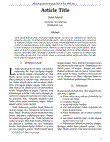Resultados de búsqueda - Tonkin~
Materias dentro de su búsqueda.
Materias dentro de su búsqueda.
- COVID-19 5
- 4
- Mexico 4
- Twitter 4
- redes sociales 4
- Communication 3
- Comunicación 3
- Educación a Distancia 3
- Facebook 3
- I21 3
- confinamiento 3
- derechos humanos 3
- social media 3
- students 3
- Aceptación de la Tecnología 2
- Artificial Intelligence 2
- Comercio Electrónico 2
- Comercio electrónico 2
- Covid-19 2
- Diffusion of Innovations 2
- Difusión de las Innovaciones 2
- Distance Education 2
- Ecuaciones Estructurales 2
- Educación Superior 2
- Educación en Línea 2
- Educación por Internet 2
- Electronic Commerce 2
- I23 2
- Information Technology in Education 2
- Internet Based Education 2
-
161
El clima de aprendizaje en la educación física, un apoyo a la autonomía, competencia y relaciones en alumnos de secundaria/preparatoria durante el confinamiento por COVID-19
Publicado 2022“…Una vez capturados los datos, estos fueron analizados mediante el programa estadístico SPSS v24, primero se llevó a cabo la depuración y calidad de los mismos, segundo, se obtuvieron resultados estadísticos descriptivos de frecuencias y porcentajes de los datos sociodemográficos, en seguida se analizaron los ítems que contempla el instrumento mediante: media, desviación típica, asimetría y curtosis, posteriormente se realizó el análisis factorial exploratorio (AFE) obteniendo el coeficiente Káiser-Meyer-Olkin (KMO), prueba de esfericidad Bartlett, método de extracción de análisis de componentes principales y método de rotación Varimax; se determinó la fiabilidad por cada factor, la cual fue calculada mediante el índice alfa de Cronbach (Cronbach, 1951), además se llevaron a cabo las comparaciones mediante la t de student según género y escuela de formación profesional, y finalmente la correlaciones entre factores por medio del coeficiente de Pearson. …”
Enlace del recurso
Tesis -
162
Sensibilidad y especificidad de la linfocitosis en la biometría hemática como herramienta diagnóstica para tos ferina en pacientes pediátricos con síndrome coqueluchoide
Publicado 2019“…La tosferina (coqueluche o pertussis), es una infección del tracto respiratorio causada por bacterias del género Bordetella, las cuales son Cocobacilos Gram negativos con tropismo por células ciliadas del epitelio mediante productos extracelulares, como la citotoxina traqueal y la PT (“pertussis toxin”), la bacteria es capaz de eliminar los cilios del sistema respiratorio, provocando una tos persistente, el signo más característico de la infección. …”
Enlace del recurso
Tesis -
163
Sensibilidad y especificidad de la linfocitosis en la biometría hemática como herramienta diagnóstica para tos ferina en pacientes pediátricos con síndrome coqueluchoide
Publicado 2019“…La tosferina (coqueluche o pertussis), es una infección del tracto respiratorio causada por bacterias del género Bordetella, las cuales son Cocobacilos Gram negativos con tropismo por células ciliadas del epitelio mediante productos extracelulares, como la citotoxina traqueal y la PT (“pertussis toxin”), la bacteria es capaz de eliminar los cilios del sistema respiratorio, provocando una tos persistente, el signo más característico de la infección. …”
Enlace del recurso
Tesis -
164
Actividad antimicrobiana de compuestos polifenólicos provenientes de extractos de cáscaras de nuez contra Salmonella sp aplicados en el proceso de comercialización de melón (Cucumi...
“…Pecan shell is a great source of natural antimicrobial agents and it is considered as a waste, resulting in a profitable tannin source. The aim of this work was to use an aqueous extract obtained of Pecan shell as an antimicrobial agent in the washing step in melon processing and to evaluate its antimicrobial effect In vitro and on Cantaloupe melon. …”
Enlace del recurso
Tesis -
165
Actividad antimicrobiana de compuestos polifenólicos provenientes de extractos de cáscaras de nuez contra Salmonella sp aplicados en el proceso de comercialización de melón (Cucumi...
“…Pecan shell is a great source of natural antimicrobial agents and it is considered as a waste, resulting in a profitable tannin source. The aim of this work was to use an aqueous extract obtained of Pecan shell as an antimicrobial agent in the washing step in melon processing and to evaluate its antimicrobial effect In vitro and on Cantaloupe melon. …”
Enlace del recurso
Tesis -
166
Un análisis del concepto de empoderamiento en la práctica del trabajo social
Publicado 2017“…Modern Social Work Theory. 2a.ed.Lyceum Books,Inc. Chicago,Illinois. Rankin, P.(2007). Exploring and Describing the Strength/Empowerment Perspective in Social Work. …”
Enlace del recurso
Artículo -
167
Evaluación de bacterias marinas y su potencial uso como aditivo en alimento y/o agente probiótico contra Vibrio parahaemolyticus, agente causal de la enfermedad de la necrosis Hepa...
Publicado 2018“…The causal agent Vibrio parahaemolyticus, colonize the stomach and produce a lethal toxin for shrimp hepatopancreas. During 2013, in Mexico this disease devastated 60-80% of the shrimp farms of Sonora, Sinaloa and Nayarit. …”
Enlace del recurso
Tesis -
168
Evaluación de bacterias marinas y su potencial uso como aditivo en alimento y/o agente probiótico contra Vibrio parahaemolyticus, agente causal de la enfermedad de la necrosis Hepa...
Publicado 2018“…The causal agent Vibrio parahaemolyticus, colonize the stomach and produce a lethal toxin for shrimp hepatopancreas. During 2013, in Mexico this disease devastated 60-80% of the shrimp farms of Sonora, Sinaloa and Nayarit. …”
Enlace del recurso
Tesis -
169
Cuestionario de bruxismo autoinformado. Estudio piloto en el noreste de México
Publicado 2019“…The sample adequacy coefficients, the Kaiser Meyer-Olkin (KMO = .826) and Bartlett's Sphericity test (χ2 = 579.866, p = .000) were assessed and expressed an appropriate intercorrelation between items. …”
Enlace del recurso
Artículo -
170
Desarrollo de una vacuna oral contra Helicobacter pylori basada en la expresión de un antígeno multi-epítopo en Lactococcus lactis recombinante.
Publicado 2019“…Our multi-epitope vaccine is composed of the cholera toxin B subunit (CTB) from Vibrio cholerae that is used as a mucosal adjuvant to improve oral immunogenicity. …”
Enlace del recurso
Tesis -
171
Desarrollo de una vacuna oral contra Helicobacter pylori basada en la expresión de un antígeno multi-epítopo en Lactococcus lactis recombinante.
Publicado 2019“…Our multi-epitope vaccine is composed of the cholera toxin B subunit (CTB) from Vibrio cholerae that is used as a mucosal adjuvant to improve oral immunogenicity. …”
Enlace del recurso
Tesis -
172
Valor nutritivo de las hojas de la hojarasca del matorral espinoso tamaulipeco en el estado de Nuevo León
Publicado 2020“…In the 2007 sampling, it was found: neutral detergent fiber (annual average NDF = 40.8%), acid detergent fiber (ADF; 28.8%), lignin (20.2%), crude protein (PC: 11.5%), condensed tannins (CT: 0.6%) and ethereal extract (EE; 2.9%) and IVOMD (63.0%) the values of the litterfall leaf samples were significantly different between sites and months, the site * month interaction was significant (P <0.05). …”
Enlace del recurso
Tesis -
173
Valor nutritivo de las hojas de la hojarasca del matorral espinoso tamaulipeco en el estado de Nuevo León
Publicado 2020“…In the 2007 sampling, it was found: neutral detergent fiber (annual average NDF = 40.8%), acid detergent fiber (ADF; 28.8%), lignin (20.2%), crude protein (PC: 11.5%), condensed tannins (CT: 0.6%) and ethereal extract (EE; 2.9%) and IVOMD (63.0%) the values of the litterfall leaf samples were significantly different between sites and months, the site * month interaction was significant (P <0.05). …”
Enlace del recurso
Tesis -
174
THE ONTO-GEOGRAPHICAL STRUCTURE OF WORLD-CULTURE AND THE POSITION, HE POSITION, OPPORTUNITY AND TASK OF AFRICA
Publicado 2022“…In this context, as relevant basical cultures we will take in consideration primarily the extensive cultural areas of the continents Europe, Africa and Asia. Also the cultures of America and LatinAmerica seem to be founded in an amalgamation of these great basical cultures; so we will confine our analysis to them. …”
Enlace del recurso
Artículo -
175
-
176
Mexican design of a tokamak experimental facility
“…This present design aims to generate, innovate, understand and develop scientific and technological fusion knowledge, also to form researchers in fusion confinement area. We consider at this time that nuclear fusion represents an attractive, powerful and clean energy source. …”
Enlace del recurso
Artículo -
177
El delito de feminicidio y sus diversos aspectos legales en México, 2018-2022
Publicado 2023Enlace del recurso
Artículo -
178
Síndrome de Burnout, la Enfermedad Menos Preciada del Siglo XXI
Publicado 2022Enlace del recurso
Artículo -
179
Detoxification of Aflatoxin-Contaminated Maize by Neutral Electrolyzed Oxidizing Water
Publicado 2015“…However, aflatoxin-associated cytotoxicity and OPEN ACCESS Toxins 2015, 7 4295 genotoxicity effects were markedly reduced upon treatment. …”
Enlace del recurso
Artículo -
180
Global Trends in Aquaculture and Feed Ingredient Use in Compound Aquafeeds
Publicado 2013“…By region, Asia accounted for over 91.2 percent of total global aquaculture production in 2011 (APR 8.46 percent since 1984), followed by the Americas at 3.53 percent (APR 7.59 percent), Europe at 3.20 percent (APR 3.99 percent), Africa at 1.84 percent (APR 14.82 percent), and Oceania at 0.25 percent (APR 9.02 percent).In terms of the major farmed species groups in 2011, finfish accounted for 41.6 million tonnes or 49.8 percent of total global aquaculture production in 2011 (valued at US $ 83.6 billion, with over 102 reported fish species, and production growing at an average APR of 8.85 percent since 1984), followed by aquatic plants at 21.0 million tonnes or 25.1% of total global production (valued at US $ 5.5 billion, with 12 reported aquatic plant species, and production growing at an average APR of 7.16 percent since 1984), molluscs at 14.4 million tonnes or 17.2 percent of total global production (valued at US $ 15.3 billion, with 27 reported mollusk species, and production growing at an average APR of 7.17 percent since 1984), and crustaceans at 5.9 million tonnes or 7.0 percent of total global production (valued at US $ 28.4 billion, with 15 reported crustacean species, and production growing at an average APR 13.1 percent since 1984; FAO, 2013).The total production of the major finfish and crustacean species groups fed industrially compounded or farm-made aquafeeds was reported to be 40.57 million tonnes in 2011 (FAO, 2013), with total global industrial compound aquafeed production estimated at approximately 35.75 million tonnes; the major compound feed fed species groups including: Chinese carp at 11.76 million tonnes (excluding silver carp and big head carp) with an estimated total compound aquafeed requirement of 10.19 million tonnes; Tilapia at 3.96 million tonnes with an estimated total compound aquafeed requirement of 5.79 million tonnes or 16.2 percent of total global compound aquafeed production;Shrimp at 3.93 million tonnes with an estimated total compound feed requirement of 5.54 million tonnes or 15.5 percent of total global compound aquafeed production; Catfish at 3.38 million tonnes with an estimated total compound feed requirement of 3.70 million tonnes or 10.3 percent of total global compound aquafeed production; Marine fish at 2.01 million tonnes with an estimated total compound feed requirement of 2.82 million tonnes or 7.9 percent of total global compound aquafeed production; Other freshwater and diadromous fish at 1.94 million tonnes with an estimated total compound feed requirement of 1.24 million tonnes or 3.5 percent of total global compound aquafeed production; Salmon at 1.93 million tonnes with an estimated total compound feed requirement of 2.51 million tonnes or 7.0 percent of total global compound aquafeed production; Freshwater crustaceans at 1.67 million tonnes with an estimated total compound feed requirement of 1.71 million tonnes or 4.8 percent of total global compound aquafeed production; Milkfish at 891,407 tonnes with an estimated total compound feed requirement of 820,000 tonnes or 2.3 percent of total global compound aquafeed production; Trout at 791,959 tonnes with an estimated total compound feed requirement of 1.03 million tonnes or 2.9 percent of total global compound aquafeed production; Eel at 255,284 tonnes with an estimated total compound feed requirement of 392,000 tonnes or 1.1 percent of total global compound aquafeed production in 2011.In terms of feed ingredient usage, the compound aquafeed sector still remains the largest consumer of fishmeal and fish oil, aquaculture consuming 78 percent of total global fish oil production in 2011 (major aquaculture species group consumer being salmonids at 66 percent followed by marine fish at 17 percent) and 68% of total global fishmeal production in 2011 (major aquaculture species group consumer being crustaceans at 30 percent, followed by salmonids at 22 percent, and marine fish at 21 percent; Dr Andrew Jackson, personal communication, The Marine Ingredients Organization, http://iffo.net). …”
Enlace del recurso
Artículo


